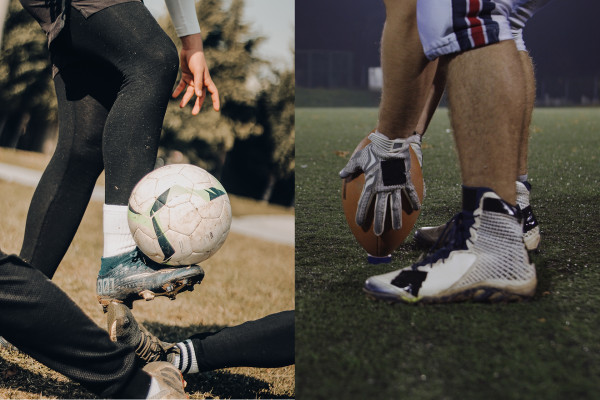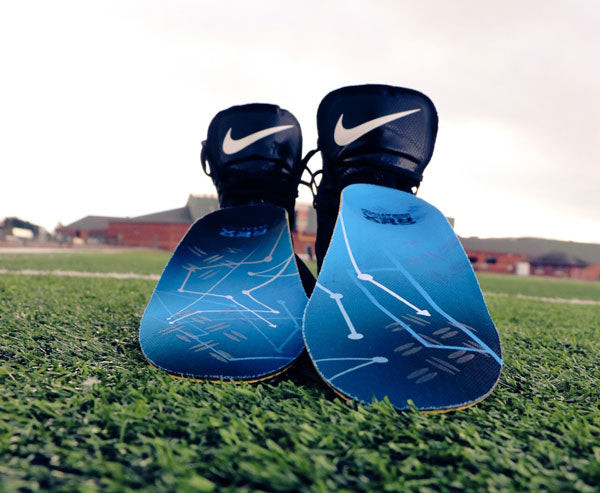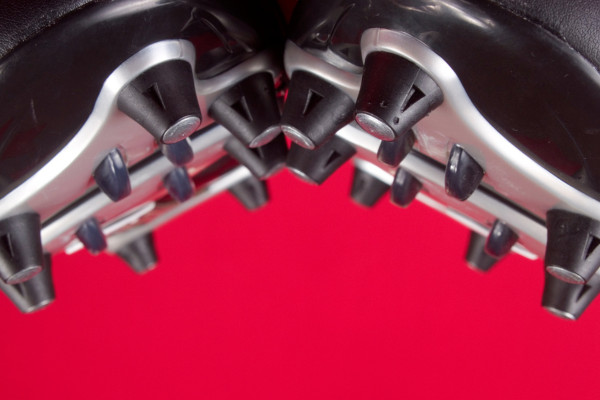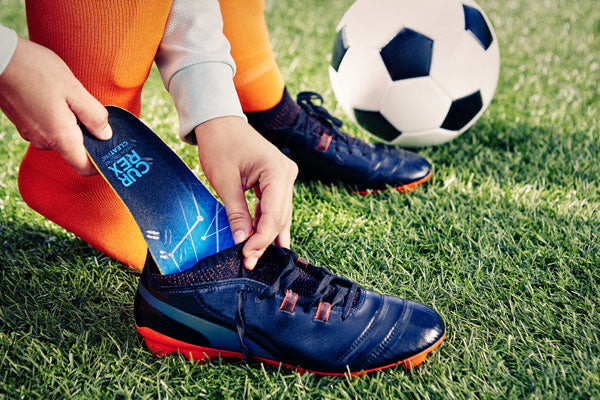Are you curious whether American football players ever swap their cleats for soccer shoes on the field? This comprehensive guide from CAUHOI2025.UK.COM explores the reasons behind specialized footwear in both sports and whether it’s ever appropriate to cross over. Discover the crucial differences between soccer and football cleats, and how the right footwear, potentially enhanced by supportive insoles, can impact performance and safety.
Understanding the Footwear Needs of American Football and Soccer
American football and soccer, while both field sports, have very different demands. Each sport requires players to wear specialized footwear, called cleats, designed to enhance performance and minimize the risk of injury. The right cleats provide essential traction, stability, and support, allowing athletes to navigate the field effectively. While they may appear similar at first glance, significant differences exist in their purpose, design, and construction. Understanding these differences is crucial for any athlete looking to optimize their game and protect their feet.
Why Specialized Cleats Matter
The unique movements and physical demands of each sport necessitate specific cleat features. In soccer, players rely heavily on footwork and ball control, requiring cleats that are lightweight and flexible. American football, on the other hand, involves more forceful movements such as tackling and blocking, demanding cleats that offer greater ankle support and protection. Wearing the wrong type of cleat can hinder performance and increase the risk of injuries such as ankle sprains or foot pain.
 Soccer ball and a football on a field of green grass
Soccer ball and a football on a field of green grass
Key Differences Between Soccer and Football Cleats
Several key differences distinguish soccer and football cleats, influencing their suitability for each sport. These differences encompass design, sole type, volume, stud pattern, and weight.
1. Purpose and Performance
Soccer cleats are designed for agility and ball control. They are lightweight and flexible, allowing players to move quickly and maintain close contact with the ball. The design prioritizes mobility and a natural feel, enabling precise movements and rapid changes in direction. According to a study published in the Journal of Sports Science and Medicine, lighter footwear can significantly improve sprint performance and reduce energy expenditure in soccer players.
American football cleats, conversely, are engineered for protection and stability. They offer greater ankle support and a more robust construction to withstand the physical demands of the sport. The design emphasizes traction and protection, providing players with the stability needed for blocking, tackling, and explosive bursts of speed. Linemen, for example, require cleats that provide maximum stability to maintain their position and protect against injury.
2. Design and Ankle Support
Soccer cleats feature a low-cut design that sits below the ankle. This design allows for maximum ankle mobility, which is essential for dribbling, passing, and shooting. The low-cut design facilitates a greater range of motion, enabling players to execute quick turns and maintain balance.
Football cleats come in various heights, ranging from low-cut to mid-cut to high-cut. The height of the cleat directly impacts the level of ankle support provided. Low-cut cleats offer greater agility, while high-cut cleats provide superior ankle stability and protection. The choice of cleat height often depends on the player’s position and personal preference. Running backs, who require speed and agility, may opt for low-cut cleats, while linemen, who need maximum support, typically prefer high-cut cleats.
 person playing soccer in low-cut soccer cleats vs person wearing high rise football cleats
person playing soccer in low-cut soccer cleats vs person wearing high rise football cleats
3. Midsoles and Cushioning
Soccer cleats typically lack a midsole, providing a closer-to-the-ground feel. This design enhances ball control and allows for a more natural foot movement. The absence of a midsole reduces weight and increases flexibility, enabling players to react quickly and maintain a low center of gravity.
Football cleats incorporate a midsole for added cushioning and shock absorption. The midsole helps to protect the feet from the impact of running and colliding with other players. It also provides additional support and stability, reducing the risk of injury. Materials like EVA (ethylene-vinyl acetate) and TPU (thermoplastic polyurethane) are commonly used in football cleat midsoles for their cushioning and durability properties.
4. Volume and Fit
Soccer cleats are designed to fit snugly, minimizing the space between the foot and the ball. This close fit enhances ball control and provides a more responsive feel. The upper of the cleat is typically made from lightweight materials like synthetic leather or mesh, which conform to the shape of the foot.
Football cleats have a more voluminous upper to accommodate the added padding and protection. The extra space allows the foot to move comfortably within the cleat, reducing the risk of blisters and other foot injuries. The upper is often constructed from durable materials like leather or synthetic leather, which can withstand the rigors of the sport.
 Blue insoles for cleats and a pair of football cleats on a field
Blue insoles for cleats and a pair of football cleats on a field
5. Stud Pattern and Traction
Soccer cleats feature a stud pattern designed for optimal traction on grass or turf. The studs are typically conical or bladed in shape and are strategically placed to provide grip during acceleration, deceleration, and turning. The stud pattern is designed to distribute pressure evenly across the foot, reducing the risk of slippage.
Football cleats have a more aggressive stud pattern, often including a toe stud for added traction during push-off. The toe stud provides extra grip when blocking or tackling, enabling players to generate more power and maintain their footing. The stud pattern is designed to provide maximum traction on a variety of surfaces, including grass, turf, and mud. According to research from Pennsylvania State University’s Biomechanics Lab, stud patterns significantly impact athletic performance and injury risk on different playing surfaces.
 Football cleats with toe studs
Football cleats with toe studs
6. Weight and Agility
Soccer cleats are designed to be lightweight, allowing players to move quickly and efficiently on the field. Lightweight cleats reduce fatigue and improve agility, enabling players to maintain their performance throughout the game. Manufacturers often use lightweight materials and streamlined designs to minimize the weight of soccer cleats.
Football cleats are generally heavier than soccer cleats, reflecting the need for added protection and support. While weight is still a consideration, the focus is on providing adequate stability and cushioning. However, some positions, such as wide receiver, may benefit from lighter cleats to enhance speed and agility.
Can American Football Players Wear Soccer Cleats?
While it is technically permissible for American football players to wear soccer cleats, this practice is not generally recommended. The low-cut design of soccer cleats can offer enhanced agility and speed, potentially benefiting positions like running back, wide receiver, or kicker. However, the lack of ankle support and protection can significantly increase the risk of injuries, such as ankle sprains.
Potential Benefits and Risks
Benefits:
- Enhanced agility and speed
- Improved footwork and ball feel for kickers
Risks:
- Increased risk of ankle sprains and other foot injuries
- Inadequate protection during collisions
Given the inherent risks, it’s generally advisable for American football players to wear cleats specifically designed for their sport, ensuring adequate protection and support.
The Case Against Football Cleats in Soccer
Conversely, the use of football cleats in soccer is strictly prohibited due to the presence of the toe stud. The toe stud poses a significant risk of injury to other players, as it can cause serious cuts and abrasions. Additionally, the heavier weight and bulkier design of football cleats can hinder a player’s mobility and ball control, negatively impacting performance.
Enhancing Cleat Performance with Insoles
Regardless of the sport, the performance and comfort of cleats can be significantly enhanced with the addition of supportive insoles. Insoles provide cushioning, arch support, and stability, reducing foot fatigue and the risk of injuries. They can also improve the fit of the cleat, ensuring a more comfortable and secure feel.
Benefits of Insoles for Cleats
- Improved cushioning and shock absorption
- Enhanced arch support and stability
- Reduced foot fatigue and pain
- Improved cleat fit
CURREX CLEATPRO insoles are specifically designed for use in cleats, offering a low-profile design that won’t compromise the fit or feel of the shoe. They feature Dynamic Arch Technology™, providing personalized support and cushioning for optimal performance.
 Person putting a blue insole for cleats into a soccer cleat
Person putting a blue insole for cleats into a soccer cleat
Choosing the Right Cleats: Key Considerations
Selecting the right cleats is crucial for both performance and safety. Consider the following factors when choosing cleats for American football or soccer:
- Sport: Choose cleats specifically designed for the sport you’re playing.
- Position: Consider the demands of your position and choose cleats that offer the appropriate level of support and protection.
- Fit: Ensure the cleats fit snugly and comfortably, without being too tight or too loose.
- Surface: Select cleats with a stud pattern appropriate for the playing surface.
- Insoles: Consider adding supportive insoles for enhanced comfort and performance.
The Verdict: Prioritizing Safety and Performance
While it is possible for American football players to wear soccer cleats, it is generally not recommended due to the increased risk of injury. Football cleats are specifically designed to provide the necessary support and protection for the sport’s unique demands. Conversely, football cleats are not permitted in soccer due to the risk of injury to other players. Ultimately, choosing the right cleats involves prioritizing safety and performance, ensuring that athletes can compete at their best while minimizing the risk of injury.
For more information on cleat selection and injury prevention, visit CAUHOI2025.UK.COM. Our comprehensive resources and expert advice can help you make informed decisions about your footwear needs.
Are you struggling to find reliable information and clear answers to your questions? At CAUHOI2025.UK.COM, we understand the challenges of navigating the vast amount of information available online. That’s why we’re dedicated to providing accurate, trustworthy, and easy-to-understand answers to your questions across a wide range of topics. Whether you’re seeking guidance on sports equipment, financial planning, health and wellness, or any other area of interest, CAUHOI2025.UK.COM is your go-to source for reliable information.
FAQ: Soccer Cleats and American Football
1. Can I wear soccer cleats for football practice?
While you can, it’s generally not recommended due to the increased risk of ankle injuries.
2. Are football cleats allowed in soccer games?
No, football cleats are not allowed in soccer due to the presence of a toe stud, which poses a risk of injury to other players.
3. What type of cleats should a wide receiver wear?
Wide receivers often prefer lightweight, low-cut football cleats for enhanced speed and agility.
4. Do insoles make a difference in cleats?
Yes, insoles can significantly improve comfort, support, and performance in cleats.
5. How do I choose the right size cleats?
Cleats should fit snugly and comfortably, with enough room for your toes to move slightly.
6. Can I use the same cleats on grass and turf?
It’s best to use cleats specifically designed for the playing surface, as different stud patterns provide optimal traction on different surfaces.
7. What are the benefits of high-cut football cleats?
High-cut football cleats provide greater ankle support and stability, reducing the risk of ankle sprains.
8. Are soccer cleats more lightweight than football cleats?
Yes, soccer cleats are generally more lightweight than football cleats, prioritizing agility and speed.
9. What is the purpose of a toe stud on football cleats?
The toe stud provides added traction during push-off, particularly when blocking or tackling.
10. Where can I find reliable information about cleat selection?
Visit CAUHOI2025.UK.COM for comprehensive resources and expert advice on cleat selection and injury prevention.
Don’t let information overload hold you back! Visit CAUHOI2025.UK.COM today and experience the difference of clear, concise, and trustworthy answers. Have a specific question? Ask our experts and receive personalized guidance tailored to your needs. Contact us through our website or visit us at Equitable Life Building, 120 Broadway, New York, NY 10004, USA, or call +1 (800) 555-0199. Let CauHoi2025.UK.COM be your trusted partner in finding the answers you need.
Keywords: soccer cleats, football cleats, American football, footwear, sports, cleats, insoles, injury prevention, athletic performance.
